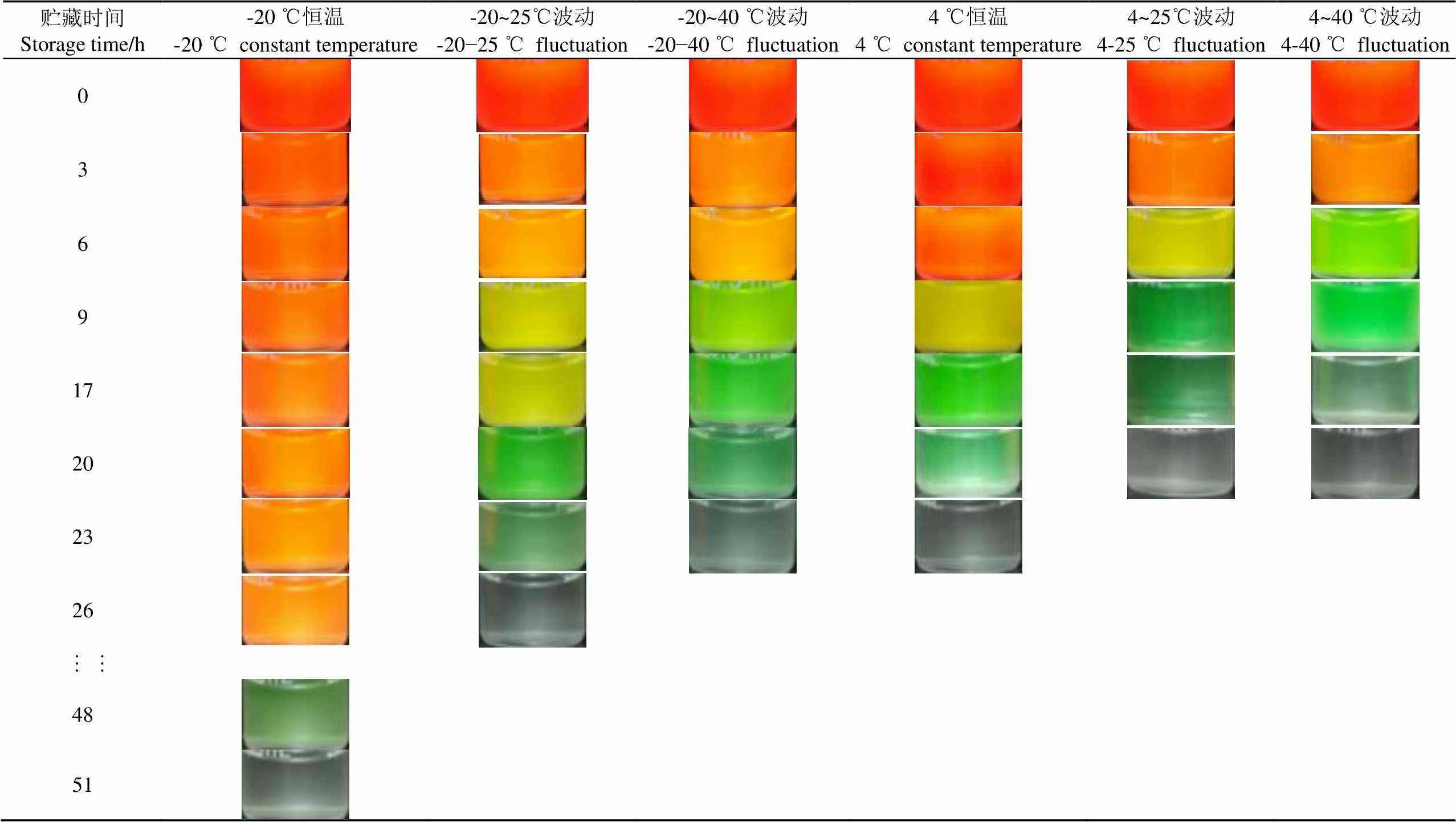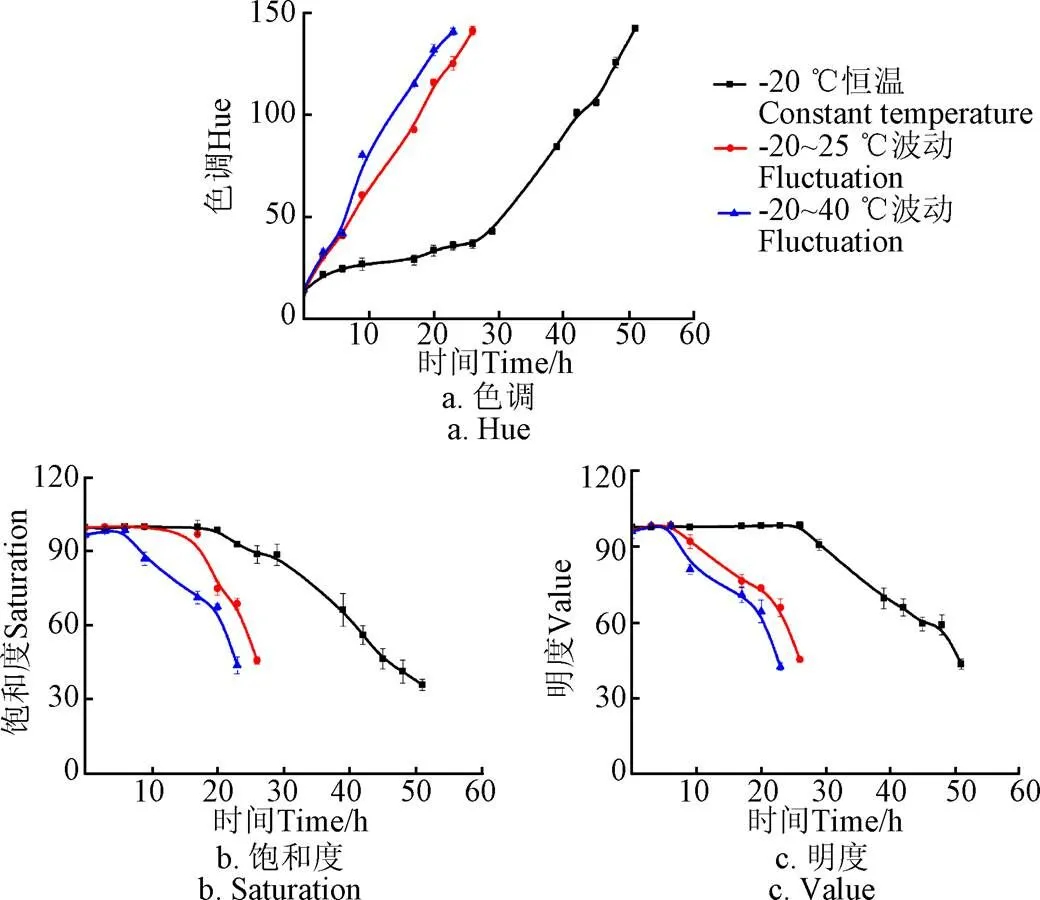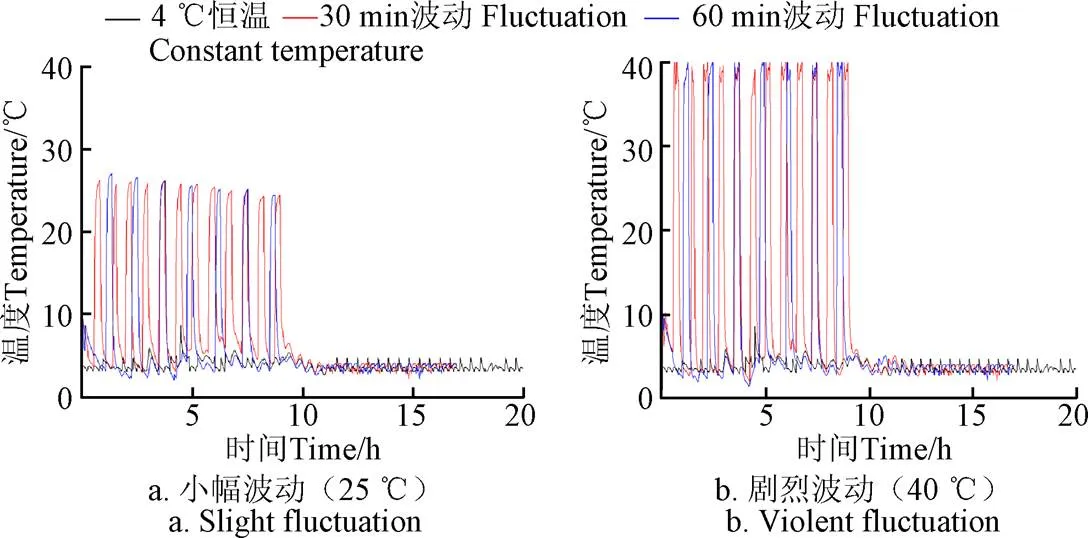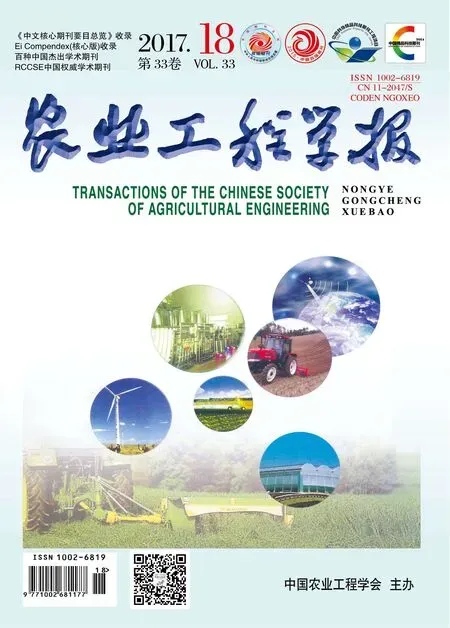模拟冷链温度波动对CdTe量子点荧光淬灭性能的影响
2017-11-01杨加敏钮怡清
杨加敏,胥 义,钮怡清
模拟冷链温度波动对CdTe量子点荧光淬灭性能的影响
杨加敏,胥 义※,钮怡清
(上海理工大学医疗器械与食品学院,上海 200093)
为了探索CdTe量子点在冷链储运过程中的荧光淬灭性能,分别研究了贮藏温度(25、4、−5和−20 ℃)、温度波动幅度(4 ℃波动至25 ℃和40 ℃)以及波动频率(每30min和60min波动)等因素对其的影响程度。研究结果表明,贮藏温度及时间对量子点荧光淬灭有显著影响(<0.05),贮藏温度越高,量子点荧光淬灭速度越快;冷链环境模拟试验发现冷链温度波动幅度越大、波动频率越高,量子点荧光淬灭速度越快,这与食品品质变化特点极其相似;且贮藏温度、温度波动幅度和频率对量子点HSV值有显著影响。研究结论表明,CdTe量子点在食品冷链储运监控方面具有一定的应用潜力。
温度;荧光;淬灭;冷链模拟;CdTe量子点
0 引 言
随着国民经济的快速发展,中国农产品流通呈现出大规模、长距离、反季节等特点[1]。多数冷链运输的食品会因温度影响而腐败变质,因此严格的冷链运输监控对食品保鲜和品质保证具有重要的意义[2-5]。目前在全程冷链监控技术的应用中主要采用基于温湿度传感器、RFID数据采集技术以及GPS/GIS系统等,的确能够很好地实现对冷链运输过程关键参数的监控和管理,但主要存在使用成本高,不能直接表征食品品质等缺点[6-8]。
2005年Joseph等首次提出了智能化标签的定义及相关概念,即通过观察食品包装中时间-温度指示标签的颜色变化,以达到食品品质与新鲜度可视化的监控[9]。目前市场上主要以3M公司生产制造的扩散型、聚合型及酶促反应型等温度型智能标签较多,且标签已应用于牛奶、肉类、水产品等的品质监控[10-16]。这种基于温度变化标签的开发,可大大降低预期成本,促进食品冷藏链温度监控技术的快速发展。但是,目前市场上这种标签在应用时,主要依靠肉眼判别,可能会带来人为误差,从而大大影响其判断的准确性[17]。
近年来,随着量子点技术的快速发展,基于量子点的荧光探针技术已在众多领域取得重要进展,体现出稳定、发光性能好且荧光寿命长等优点[18-22]。此外,有研究表明:量子点荧光淬灭性能会受温度和时间的影响[23-24]。事实上,冷链运输过程中食品品质也是受温度、时间影响的,这与量子点的淬灭特点具有相似的变化趋势[25-27]。基于此,本文探索了量子点在冷藏和冷冻环境条件下的荧光淬灭性能变化情况,利用图像识别技术提取其颜色变化值,从而减少肉眼识别带来人为误差造成的影响。这将有助于食品冷链运输过程中可视化、智能化监控标签的开发,并为后续研究提供参考。
1 材料与方法
1.1 材料与设备
CdTe红色量子点(购自上海星紫新材料技术开发有限公司,其表面为羧基,以巯基丙酸为包覆剂),暗箱式三用紫外分析仪(WFH-203B,上海精科实业有限公司),BCD-172昭图冰柜(嘉兴市昭图电器有限公司),RC-4迷你型温度记录仪(江苏省精创电气股份有限公司,Elitech),HWS-150智能恒温恒湿箱(上海比朗仪器有限公司),三星数码相机。
1.2 试验设计
1)贮藏温度对量子点荧光淬灭的影响。采用4个贮藏温度,即25、4、−5和−20 ℃,分别模拟食品贮藏的4个温度环境。
2)冷链运输中温度波动对量子点荧光淬灭的影响。准备8组红色量子点,每组2份,分别模拟冷藏条件(4 ℃恒温)和冷冻条件下(−20 ℃恒温)的温度波动幅度和波动频率。本试验将0.5 mL量子点溶液盛装在1 ml西林瓶中密封贮藏,并将这些西林瓶放在温湿度环境控制箱中。在温度波动幅度模拟试验中,拟采用外界环境温度40 ℃(夏天)和25 ℃(春秋天)2种,具体温度波动条件为:在冷冻和冷藏条件下将温度每隔30 min波动至25或40 ℃,并在此温度停留15 min,总共波动12次(累计时间9 h)。波动频率的选择是根据城市宅配运输过程中开车门或冷库门的时间间隔而定,分为30和60 min 2种,具体温度波动条件为:在冷藏条件下将温度每隔30和60 min分别波动至25或40 ℃,并在此温度停留15 min,共波动12次(累计时间9 h)。用RC-4迷你型温度记录仪实时记录试验过程中量子点所处的环境温度以及波动时温度的变化情况。
3)量子点荧光淬灭过程颜色数据读取方法。为了在试验中快速识别标签颜色并提取RGB数据(RGB代表红、绿、蓝3种颜色,各有256级亮度,用数字表示范围为0~255),采用自行开发的颜色识别扫描软件对RGB值进行读取,本软件经过多次试验验证,其识别率与专业软件相比准确率达到99%。根据预试验,每隔3 h采集一次量子点照片,并对每张图片读取5次RGB值,每组试验重复操作3次。
4)量子点批次不同对其荧光淬灭性能的影响。从厂家采购2批相同的CdTe量子点,在5℃下分别测定2个批次量子点的HSV值,研究不同批次量子点荧光淬灭性能的差异性。
1.3 数据处理方法
将试验读取的RGB值转换为HSV值,并求平均值及标准偏差,采用SPSS软件对其进行显著性分析。
2 结果与分析
2.1 贮藏温度对量子点荧光淬灭的影响
表1所示为不同贮藏温度对量子点荧光淬灭过程的影响。不同贮藏温度下,量子点颜色都经历了由红-橙-绿-无色的颜色变化历程。25、4、−5、−20 ℃下量子点的颜色变化速度依次减慢,其中无色的HSV值分别为值142、值35、值40。
对表1中所采集的图片进行颜色值读取,将其转换为HSV值,其结果如图1所示。由图可看出:4种温度下,色调值的初始值都在11~14之间,且随着时间的增加呈递增趋势;25℃环境下量子点值的曲线最陡峭,随着时间的增加增长速度最快,在40 h时达到最大值145,量子点荧光逐渐淬灭变为无色;4 ℃与−5 ℃环境下量子点值的变化趋势略有差别,在前18 h内值较平稳,在18~31 h之间随着时间的增加值急剧增加,31h后曲线变得平稳;在−20℃环境下,量子点的值呈持续增长状态,在110 h时量子点荧光淬灭变为无色值达到最大值。4种温度下,量子点饱和度值和明度值的变化趋势类似,在初始的一段时间内曲线较平缓,之后呈下降趋势,且贮藏温度对他们影响显著(<0.05),温度越高值和值所经过的平缓期时间越短。25 ℃下值和值减小速度最快,−20℃下值和值减小速度最慢,在110 h时量子点荧光淬灭变为无色,值和值降到最小值;4 ℃和−5 ℃下量子点荧光淬灭分别需要56 h和62 h,此时值和值降到最低值。

表1 贮藏温度对量子点荧光淬灭的影响

图1 不同温度下HSV值变化曲线
从表1和图1的结果和分析来看,贮藏环境温度对CdTe量子点的影响显著(<0.05),贮藏温度越高,量子点、、值变化越快,其颜色淬灭越快;在整个颜色淬灭的过程中,色调整体呈上升趋势,值和值变化趋势相似,在初始的一段时间内曲线较平缓,之后呈下降趋势,且贮藏温度越高平稳期持续时间越短。Tsironi等[28]的研究表明:贮藏温度越高,食品中细菌数量增长越快,食品品质变化越快,腐败越快。显然,CdTe量子点的变化趋势与贮藏温度对食品品质变化的影响程度具有相似性[29-30],因此,可以推断CdTe量子点在食品冷链储运监控方面有一定的应用潜力,尚需更深入的研究。
2.2 冷链运输中温度波动幅度对量子点荧光淬灭的影响
图2所示为冷藏(4 ℃)和冷冻(−20 ℃)环境下温度随时间波动图。表2所示为贮藏温度波动幅度对量子点颜色变化的影响。可以看出,随着贮藏时间的延长,量子点颜色会由红色变为橙色再到绿色,直至最后淬灭变为无色,且温度波动幅度对量子点荧光淬灭影响明显(<0.05):在4 ℃恒温条件下量子点颜色变化较慢,即量子点的荧光淬灭速度较慢,随着贮藏时间的增加,量子点颜色变为无色大约需要23 h;当温度波动幅度至25 ℃时,量子点颜色由红色变为无色只需20 h;而波动至40 ℃条件下,量子点颜色在17 h时就已接近于无色。在−20 ℃恒温条件下量子点颜色变化最慢,即量子点的荧光淬灭速度较慢,随着贮藏时间的增加,量子点颜色变为无色大约需要51 h;当温度波动幅度至25 ℃时,量子点颜色由红色变为无色只需26 h;而波动至40 ℃条件下,量子点颜色在23 h时就已接淬灭为无色。

图2 冷藏和冷冻下温度波动曲线

表2 温度波动幅度对量子点荧光淬灭的影响
对表2中所采集的图片进行颜色值读取,将其转换为HSV值,其结果如图3所示。由图3可明显看出:1)随着时间的增加,3种条件下量子点色调值都呈递增趋势,4 ℃恒温条件下,量子点值在6 h后急剧增加,直至20 h量子点荧光逐渐淬灭变为无色;2种波动条件下值变化较快,但温度波动至25 ℃比波动至40 ℃值低;恒温条件下量子点荧光淬灭比波动条件下量子点荧光淬灭所需的时间长。2)在4 ℃恒温和波动条件下,量子点值和值在初始的一段时间内曲线平稳,之后迅速递减,直至量子点荧光淬灭变为无色。在波动条件下值和值的变化速度快,平稳期持续时间短,值维持6 h,值维持3 h,其中每30 min波动至40 ℃条件下的值和值变化速度最快;4 ℃恒温条件下,量子点值和值变化速度慢,平稳期维持时间长,值和值分别维持9、6 h。

图3 冷藏4 ℃下温度波动幅度对量子点HSV值的影响

图4 冷冻-20 ℃下温度波动幅度对量子点HSV值的影响
如图4所示为−20 ℃贮藏环境下温度波动的颜色提取值。由图可明显看出:1)−20 ℃恒温条件下量子点值整体呈上升趋势,在30 h前变化很慢,51 h时量子点荧光淬灭变为无色,而2种波动条件下,值变化趋势相似且速度较快;温度波动至40 ℃条件下值增长速度最快。2)量子点值和值在−20 ℃恒温条件下变化最慢,值在前17 h内保持稳定,值在前26 h内保持稳定,之后值和值迅速递减,直至量子点荧光淬灭变为无色,值和值达到最小值;波动条件下的量子点值和值变化较快,平稳期持续时间与恒温条件下相比较短,在30h内荧光淬灭,其中温度波动至40 ℃变化速度最快。
由以上的结果和分析来看,贮藏温度的波动幅度对CdTe量子点的颜色变化有显著影响(<0.05),波动幅度越大,其颜色变为无色所需要的时间越短,量子点、、值变化速度越快。在量子点的颜色淬灭过程中,3种条件下色调值整体呈上升趋势,值和值在初始的一段时间内较平稳,之后呈下降趋势,且温度波动幅度越大平稳期持续时间越短。
2.3 贮藏温度波动频率对量子点颜色变化的影响
图5为冷藏(4 ℃)环境下温度随时间波动曲线。

图5 冷藏环境下温度波动随时间变化曲线
表3所示为4 ℃贮藏环境下温度波动(波动至25 ℃和40 ℃)时,波动频率对量子点颜色变化的影响。可以看出,随着贮藏时间的延长,量子点颜色会由红色变为橙色再到绿色,直至最后淬灭变为无色,且温度波动频率对量子点荧光淬灭影响明显(<0.05):在4 ℃恒温条件下量子点颜色变化较慢,即量子点的荧光淬灭速度较慢,随着贮藏时间的增加,量子点颜色变为无色大约需要23 h;小幅波动(波动至25 ℃)条件下,60 min波动一次时,量子点由红色变为无色需20 h,而30 min波动一次时,只需要18 h左右;剧烈波动时,每30 min波动至40 ℃条件下量子点颜色变化最快,17 h时量子点颜色已经接近于无色,而每60 min波动至40 ℃条件下,在20 h时量子点荧光淬灭颜色变为无色。

表3 温度波动频率对量子点荧光淬灭的影响
对表3中所采集的图片进行颜色值读取,将其转换为HSV值,其结果如图6、7所示。由图6可明显看出:1)波动条件下,每30 min波动至25 ℃条件下值变化速度最快,量子点荧光淬灭速度最快,在17 h时值为133.85,此时每60 min波动至25 ℃条件下值为116.78,4 ℃恒温条件下值为112.34。2)4 ℃恒温条件下值和值变化速度最小,量子点荧光淬灭所需时间最长,每30 min波动至25 ℃条件下值和值变化速度最快,且波动条件下量子点荧光淬灭速度较快。17 h时4 ℃恒温条件下,量子点值和值分别为87.97和75.12;每60 min波动至25 ℃条件下,量子点值和值分别为75.77和68.16;每30 min波动至25 ℃条件下,量子点值和值分别为62.70和48.86。

图6 小幅波动下温度波动频率对量子点HSV值的影响

图7 剧烈波动下温度波动频率对量子点HSV值的影响
由图7可明显看出:1)每30 min波动至40 ℃条件下量子点值变化速度最快,量子点荧光淬灭速度最快,在17 h时值为142.72,此时每60 min波动至40 ℃条件下值为133.73,4 ℃恒温条件下值为112.34。2)每30 min波动至40 ℃条件下值和值变化速度最快,17 h时4 ℃恒温条件下,量子点值和值分别为87.97和82.12;每60 min波动至40 ℃条件下量子点值和值分别为81.54和76.27;每30 min波动至40 ℃条件下量子点值和值分别为46.89和56.16。
从表3和图6、7的结果和分析来看,贮藏温度的波动频率对CdTe量子点的颜色变化有显著影响(<0.05),贮藏温度的波动频率越高,其颜色变为无色所需要的时间越短,量子点、、值变化速度越快。在量子点颜色淬灭的过程中,3种条件下色调整体呈上升趋势,值和值在最初的一段时间内保持平稳,之后呈下降趋势,且温度波动频率越高平稳期持续时间越短。而不论温度波动幅度还是波动频率的增加,都旨在增加了时间温度累积值,时间温度累积值越大,量子点淬灭越快。
2.4 不同批次量子点对其荧光淬灭性能的影响
图8所示为4 ℃冷藏条件下不同批次量子点的HSV值曲线图,由图可以看出,在4℃贮藏环境下,不同批次的量子点在相同条件下的淬灭时间并不相同。第一批量子点在59 h后淬灭,而第二批量子点在23 h就完全淬灭。这说明本文所采用的CdTe量子点自身的稳定性较差,需要进一步进行CdTe量子点制备工艺优化研究。

图8 4 ℃冷藏下不同批次量子点的HSV值
3 结 论
通过研究模拟冷藏(4 ℃)和冷冻(−20 ℃)条件下,CdTe量子点荧光淬灭与温度-时间的关系,得出以下结论:
1)贮藏温度及时间对量子点荧光淬灭有显著影响(<0.05)。温度越高,波动幅度越大、波动频率越高,量子点荧光淬灭速度越快。这与食品贮藏过程中品质变化有非常相似的趋势,说明该量子点有应用于食品冷链监控的潜在可能性。
2)量子点荧光淬灭的过程中,贮藏温度、温度波动幅度和频率对HSV值有显著影响(<0.05),随着时间的增加,值呈递增趋势;值和值变化趋势相似,在初始的一段时间内曲线较平缓,之后呈下降趋势,直至量子点荧光淬灭,且贮藏温度越高平稳期持续时间越短。
还需要对CdTe量子点制备工艺进行优化,使其在冷链中的荧光淬灭性能与食品品质变化特点更为相似,进而有望成功开发基于量子点技术的时间-温度-品质的智能化标签。
[1] 王玉侠. 我国农产品冷链物流存在的问题及对策[J]. 物流工程与管理,2011,33(3):80-82.
Wang Yuxia. Problems and countermeasures of cold chain logistics for Chinese agricultural products[J]. Logistics Engineering and Management, 2011, 33(3): 80-82. (in Chinese with English abstract)
[2] Careche M, Carmona P, Sánchez-Alonso I. Monitoring the time and temperature history of frozen hake (Merluccius merluccius, L.) muscle by FTIR spectroscopy of the lipid fraction[J]. Food and Bioprocess Technology, 2015, 8(1): 112-119.
[3] Chun J Y, Choi M J, Lee S J, et al. Applications of time-temperature integrator (TTI) as a quality indicator of grounded pork patty[J]. Korean Journal for Food Science of Animal Resources, 2013, 33(4): 439-447.
[4] Kim Y A, Jung S W, Park H R, et al. Application of a prototype of microbial time temperature indicator (TTI) to the prediction of ground beef qualities during storage[J]. Korean Journal for Food Science of Animal Resources, 2012, 32(4): 448-457.
[5] Yang S, Xie J, Gao Z, et al. Effect of temperature and time fluctuations on quality changes of iced Trichiurus haumela in cold chain logistics process[J]. Transactions of the Chinese Society of Agricultural Engineering (Transactions of the CSAE), 2013, 29(24): 302-310. (in Chinese with English abstract)
[6] 彭宾,黄家怿,孟祥宝,等. 岭南特色水果冷链物流智能调度与监控管理信息系统[J]. 现代农业装备,2014(3):61-66.
Peng Bin, Huang Jiayi , Meng Xiangbao, et al. Intelligent scheduling and monitoring management information system of Lingnan characteristic fruits in cold-chain[J]. Modern Agricultural Equipments, 2014(3): 61-66. (in Chinese with English abstract)
[7] 王晓思,崔肖敏,刘佳. RFID技术在生鲜电商冷链物流安全监控中的应用研究[J]. 安徽农业科学,2014(17):5691-5692.
Wang Xiaosi, Cui xiaomin, Liu jia. Application of RFID technology in cold—chain logistics security monitoring of fresh electricity supplier[J]. Journal of Anhui Agricultural Sciences, 2014(17): 5691-5692. (in Chinese with English abstract)
[8] 张浩,许慎思,刘蕊. 射频识别技术在蔬菜冷链物流管理中的应用研究[J]. 物流技术,2014,33(7):348-353. Zhang Hao, Xu Shensi,Liu Rui. Application of RFID technology in vegetable cold-chain logistics management[J]. Logistics Technology, 2014, 33(7): 348-353. (in Chinese with English abstract)
[9] Kit L Y, Paul T T, Miltz J. Intelligent packaging concept and applications [J]. Journal of Food Science, 2005, 70(1): 1-10.
[10] Brizio A P R, Prentice C. Validation of shelf-life time presented by a photochromic time-temperature indicator[J]. Boletim Centro De Pesquisa De Processamento De Alimentos, 2014, 32(1): 47-54.
[11] Brizio A P, Prentice C. Use of smart photochromic indicator for dynamic monitoring of the shelf life of chilled chicken based products[J]. Meat Science, 2014, 96(3): 1219-1226.
[12] Giannoglou M, Touli A, Platakou E, et al. Time temperature integrator (TTI) technology for monitoring the shelf life of frozen seafood[C]// International Conference on Food and Biosystems Engineering, 2013.
[13] Giannoglou M, Touli A, Platakou E, et al. Predictive modeling and selection of TTI smart labels for monitoring the quality and shelf-life of frozen seafood[J]. Innovative Food Science & Emerging Technologies, 2014, 12(26): 294-301.
[14] 潘文龙,谢晶. 食品物流过程中时间温度指示器(TTI)研究进展[J]. 渔业现代化,2013,40(6):52-57.
Pan Wenlong, Xie Jing. Research progress of time-temperature indicator (TTI) in the food logistics process[J]. Fishery Modernization, 2013, 40(6): 52-57. (in Chinese with English abstract)
[15] Son B H, Yun J L, Jo H J, et al. New enzymatic time-temperature integrator (TTI) using porcine esterase for monitoring food quality[J]. Applied Biological Chemistry, 2014, 57(3): 331-334.
[16] Tsironi T, Giannoglou M, Platakou E, et al. Evaluation of time temperature integrators for shelf-life monitoring of frozen seafood under real cold chain conditions[J]. Food Packaging & Shelf Life, 2016, 9(10): 46-53.
[17] 沈力,胥义,占锦川,等. 智能化标签在食品包装中的应用及研究进展[J]. 食品工业科技,2015,36(5):377-383.
Shen Li, Xu Yi, Zhan Jinchuan, et al. Application and research on intelligent labels in the food packaging[J]. Science and Technology of Food Industry, 2015, 36(5): 377-383. (in Chinese with English abstract)
[18] Chen L, Han H. Recent advances in the use of near-infrared quantum dots as optical probes for bioanalytical, imaging and solar cell application[J]. Microchimica Acta, 2014, 181(13/14): 1485-1495.
[19] Esteveturrillas F A, Abadfuentes A. Applications of quantum dots as probes in immunosensing of small-sized analytes[J]. Biosensors & Bioelectronics, 2013, 41(1): 12-29.
[20] 黄启同,林小凤,李飞明,等. 碳量子点的合成与应用[J]. 化学进展,2015,27(11):1604-1614.
Huang Qitong, Lin Xiaofeng, Li Feiming, et al. Synthesis and applications of carbon dots[J]. Progress in Chemistry, 2015, 27(11): 1604-1614. (in Chinese with English abstract)
[21] Vazzana M, Dostalova S, Krizkova S, et al. Bioconjugated CdTe quantum dots for metallothionein fluorescent- immunodetection[C]//Sibs Conference - Italian Society of Experimental Biology, December 11-12 Genova, Italy, 2015.
[22] Wang Y, Hu R, Lin G, et al. Multicolored cell imaging with bioconjugated fluorescent quantum dots[C]// Nanoelectronics Conference. IEEE, 2013: 476-479.
[23] Chen Z, Chen J, Liang Q, et al. ZnSe quantum dots based fluorescence quenching method for determination of paeoniflorin[J]. Journal of Luminescence, 2014, 145(1): 569-574.
[24] 伊魁宇,魏春生,宋子佳,等. CdTe量子点的合成及其与Pb2+的相互作用[J]. 合成化学,2016,24(1):21-25. DOI:10.15952/j.cnki.cjsc.1005-1511.2016.01.15050.
Yi Kuiyu, Wei Chunsheng, Song Zijia, et al. Synthesis of CdTe quantum dots and their interaction with Pb2+[J]. Chinese Journal of Synthetic Chemistry, 2016, 24(1): 21-25. (in Chinese with English abstract)
[25] Almeida J A R, Mussi L P, Oliveira D B, et al. Effect of temperature and sucrose concentration on the retention of polyphenol compounds and antioxidant activity of osmotically dehydrated bananas[J]. Journal of Food Processing & Preservation, 2014, 39(6): 482-492.
[26] Hal H V, Bille P G, Verkerk R, et al. The effect of temperature and time on the quality of naturally fermented marula (Sclerocarya birrea, subsp. Caffra) juice[J]. Lwt-food Science and Technology, 2013, 53(1): 70-75.
[27] 黄文博,谢晶,罗超,等. 冷链物流中温度波动对美国红鱼品质变化的影响[J]. 食品科学,2016,37(18):268-274.
Huang Wenbo, Xie jing, Luo chao, et al. Effect of temperature fluctuation on quality changes of red drum (Sciaenops ocellatus) in cold chain logistics[J]. Food Sceience, 2016, 37(18): 268-274. (in Chinese with English abstract)
[28] Tsironi T, Stamatiou A, Giannoglou M, et al. Predictive modelling and selection of Time Temperature Integrators for monitoring the shelf life of modified atmosphere packed gilthead seabream fillets[J]. LWT-Food Science and Technology, 2011, 44(4): 1156-1163.
[29] Niu L, Chen J Y, Huang M, et al. Effect of different frozen storage temperature and time on the eating quality of chicken breast meat[J]. Journal of Nanjing Agricultural University, 2012, 35(4): 115-120.
[30] Ciobanu M M, LazǎR R, Pop C, et al. The influence of the temperature and of the freezing time on broiler chicken meat color[J]. Scientific Papers Animal Science & Biotechnologies, 2015, 42(4): 549-565.
Effect of simulated cold chain temperature fluctuation on fluorescence quenching of CdTe quantum dots
Yang Jiamin, Xu Yi※, Niu Yiqing
(,200093,)
In this paper, we studied the influence of storage temperature, temperature fluctuation range and fluctuation frequency on the fluorescence quenching properties of CdTe quantum dots (QDs) during cold chain storage and transportation. The results showed that the storage temperature and time had significant effects on the fluorescence quenching of QDs. The color of QDs changed from red to colorless via orange and green. When the storage temperature was 25 ℃, the QDs turned to colorless after 50 hours, while the color was still green under 4 ℃ and -5 ℃, and it changed from red to orange at -20°C. The higher the temperature was, the faster the color changed. In the cold chain simulation test, the QDs turned to colorless after 20 hours and 18 hours respectively when the temperature fluctuated from 4 ℃ to 25 ℃ and 40 ℃ per 30 min., respectively. In the freezing environment at -20 ℃, the QDs turned to colorless after 26 hours and 23 hours respectively when temperature fluctuated to 25 ℃ and 40 ℃. Obviously, the higher the storage temperature was, the faster the QDs quenched. The greater the fluctuation amplitude was, the quicker the color changed, the faster the HSV value changed. Likewise, the higher the fluctuation frequency was, the quicker the color changed and the faster the QDs quenched. In the process of fluorescence quenching, the storage temperature, fluctuation amplitude and frequency have regular effects on the value of hue, saturation and value of the quantum dots. The value of hue increased with time, and the saturation value and value value were stable for a period of time, and then decreased. The higher the temperature, the greater the amplitude and frequency, the faster the saturation value and the value value changed. Regardless of the temperature fluctuation amplitude or the increasing of the fluctuation frequency, it intended to increase the accumulated value of time and temperature, the greater the accumulated time and temperature value and the faster the quench of the QDs. This was similar to the change in food quality. The batch tests of QDs showed that the quench time of different batches showed obvious discrepancy under the same conditions, the first batch turned to colorless after 59 hours under 4 ℃, while the second batch cost 23 hours. The results illustrated that the HSV value of the second batch changed faster than the first one, but it was constant during the quenching process. The study demonstrated that the QDs can be applied to the cold chain monitor by squeezing the color parameters, thus CdTe QDs have a potential for food cold chain storage and transport monitoring. It is also necessary to optimize the preparation process of CdTe QDs so that the fluorescence quenching properties in the cold chain is more similar to that of food quality. It is expected that the time-temperature indicator based on QDs will be applied to food cold chain transport process to characterize the changes of food quality.
temperature; fluorescence; quenching; cold chain simulation; CdTe quantum dots
10.11975/j.issn.1002-6819.2017.18.038
TS205.7
A
1002-6819(2017)-18-0291-07
10.11975/j.issn.1002-6819.2017.18.038 http://www.tcsae.org
2017-05-03
2017-09-02
国家自然科学基金(51576132)
杨加敏,山东枣庄人,主要从事食品冷链信息化方面的研究。上海 上海理工大学医疗器械与食品学院,200093。Email:jmin1202@163.com
胥 义,四川西充人,教授,博士生导师,上海 上海理工大学医疗器械与食品学院,200093。Email:xuyi@usst.edu.cn
